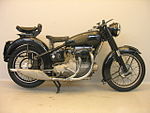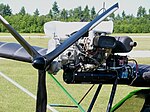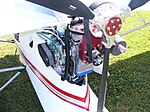Loading AI tools
An Inline-twin, inline twin-cylinder, or in-line vertical-twin[1] is an internal combustion engine in which the axis of the crankshaft is inline with axis of the final drive or chassis of the vehicle.[2] It is also known as "in-line" and tandem twin. An inline-twin engine differs from the two cylinder engine design known as a parallel-twin engine which has its crankshaft at a transverse or right angle to final drive and the chassis of the vehicle.[3] An inline-twin, having its crankshaft parallel to the direction of the chassis or drive, is described as being longitudinal, hence the differentiation between transverse and longitudinal parallel twins.[3]

Such engines have commonly been used in snowmobile,[4][5][6] ultralight aircraft,[7][8] tractor,[9] ATV, Superkart,[10] motorcycle,[11] marine,[12] large scale flying model aircraft[13] and automotive[14][15][16] applications including passenger, transportation and sports uses.
The design has been used for two-stroke, four-stroke, and diesel engines,[17] air-cooled and water-cooled, and aspirated by both carburettors and turbochargers.[18]
Inline twins have the advantage of being compact, relatively simple, and cheap to make in comparison to V or flat twins.[19] As with any twin cylinder engine, they have an imbalanced firing action which causes vibration and inline-twins also suffer further from torsional torque reactions and vibration.[20]
Inline-twins were used in the early days of motoring in models such as the 1898 Decauville Voiturelle which used a pair of cylinders taken from a de Dion model mounted fore and aft and positioned below the seat.[21]
In 1955, engineer Aurelio Lampredi designed an experimental inline twin cylindered F1 engine on the theory that it would provide high levels of torque for tight race circuits. The result was the 2.5-liter Type 116 prototype. Unfortunately, it vibrated so badly it broke the testbench and never made it into production. [22]
- Inline marine engines
Inline twins are common in marine use both inboard and outboard, such as the Suzuki 15 models,[23] and as jet pump motors. [24]
As early as the 1950s, and contrary to the automotive industry, manufacturers of outboard motors had settled on the use of the basic inline engine design, cylinders stacked on top of each other with the crankshaft driving the propellor shaft. Experimental engines even used two inline engine blocks joined in order to make a Square engine. [25]
- Inline-twin Motorcycles
- Dresch 500cc Monobloc
- Sunbeam S8
- Kawasaki KR 250
In motorcycling, the term "in-line engine" is used narrowly, for a straight engine mounted in line with the frame.[26] The inline-twin engine design has been used often during the history of motorcycling for both two-stroke and four-stroke engines. Examples include, the Dresch 500 cc Monobloc, the Sunbeam S7 and S8,[1][27] Kork Ballington's world championship winning Kawasaki KR 250 and 350s[28] and Aprilia's 1985 GP racing bikes,[11] and the CCM Armstrong 250cc, Waddon, EMC, Hejira, Decorite, Cotton racers which all used the Rotax model 256 inline twin engine.[29] The Kawasaki KR models won 8 world championships [11] and were instrumental in establishing the company as a manufacturer of high performance motorcycles.[30]
Inline-twin engines have both advantages and disadvantages for motorcycle design. Although it is a narrow twin engine design that allows for a narrow motorcycle, as narrow as a single cylinder engine,[31] they also create a longer engine. A significant disadvantage for air-cooled engines is that the rear cylinder runs hotter than the front cylinder.[20][32] For motorcycle racing purposes, they minimise the front area of the engine and chassis allowing for a more aerodynamic and narrower front profile equivalent to a single cylinder vehicle.
Tandem twin engine
This section needs expansion. You can help by adding to it. (July 2012) |

In inline tandem twins, the motor has two crankshafts,[33][34] one for each cylinder[35][36] which are joined and kept in co-ordinated by load carrying, crank-phasing gears connecting the two cylinders. [37] The design has been used in motorcycling, and go-kart racing.
Between 1975 and 1982, Kawasaki used the design to win 8 250cc and 350cc world championships before retiring.[38] The engine design was also used for a road legal production motorcycle inspired by the racer.[39]
- Ultralight aircraft engines
- A Rotax inline aircraft engine
- A Rotax 503 engine
- A Rotax 582 engine
Inline-twin engines, such as the Hirth 2704 are commonly used in Ultralight, single seat gyrocopters and small homebuilt aircraft [40] originally sourced from snowmobiles.[41] Another popular inline-twin two-stroke engine was the Cuyuna 430-D, also a modified snowmobile unit[42] which produced 30 hp[43] More modern Ultralights tend to use engines such as the Rotax 503 which are designed for the purpose. [44]
Wikiwand in your browser!
Seamless Wikipedia browsing. On steroids.
Every time you click a link to Wikipedia, Wiktionary or Wikiquote in your browser's search results, it will show the modern Wikiwand interface.
Wikiwand extension is a five stars, simple, with minimum permission required to keep your browsing private, safe and transparent.








